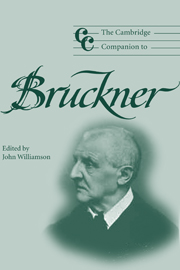4 - Bruckner's large sacred compositions
from Part II - Choral music
Published online by Cambridge University Press: 28 September 2011
Summary
I climbed to the organ gallery, the cheapest section of the Grosser Musikvereinsaal, and stood with Bruckner . . . through a badly cut and poorly prepared performance of the Berlioz Te Deum . . . The master was completely captivated, though he had a threatening expression on his face. After the concert, although the work had clearly made an impression, not a word escaped his lips for a long time. He quickly and firmly grabbed my arm and stormed off to the restaurant Stadt Frankfurt where he invited me to his favourite meal in those days, capon and apple puree. Suddenly he gave me a hefty poke in the side with his elbow and burst out with a summary of his conflicting deliberations: ‘and ecclesiastical it isn’t!’
August Göllerich relates this anecdote in his chapter about Viennese concert life and Bruckner's work on his own Te Deum in 1884. In the context of a discussion of Bruckner's large sacred compositions, while admitting the futility of trying to read the composer's mind through Göllerich's filter, it is tempting to speculate as to the nature of the deliberations inspired by Berlioz's monumental work. At the very least it is safe to say that ‘and ecclesiastical it isn't!’ states the obvious: the Berlioz performance had not taken place in church. Göllerich's narrative suggests a more critical stance on Bruckner's part. Perhaps the composer was pondering issues of musical style: had Berlioz, whom he admired, provided an appropriate setting for a sacred Latin text – a text that had been very much on Bruckner's mind in recent months? Or by ‘kirchlich’ did he mean ‘liturgical’, thus questioning the appropriateness of the Berlioz work for use as service music? Perhaps venue and content intersected in Bruckner's mind, and the Berlioz performance caused him to deliberate on broader, one might say Wagnerian, issues of where and how sacred and secular overlap. He had already been accused himself of turning the Credo of the F minor Mass in to a religious ‘Wolf ‘s Glen Scene’. Given that he would finish his career with a symphony dedicated to God, and propose his Te Deum as a suitable Finale, it may not be far fetched to speculate that weighty aesthetic questions of meaning and function in sacred as opposed to secular music were on his mind as he climbed to and from the organ gallery that evening in 1884.
- Type
- Chapter
- Information
- The Cambridge Companion to Bruckner , pp. 39 - 53Publisher: Cambridge University PressPrint publication year: 2004



